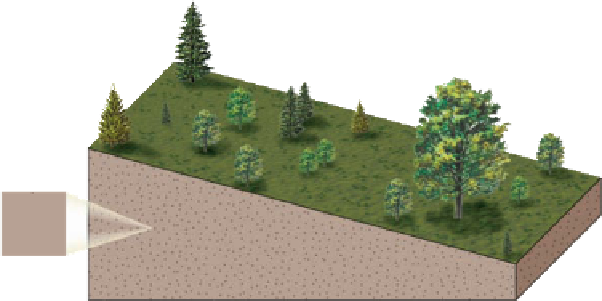Geology Reference
In-Depth Information
Gravitational Force
◗
Figure 11.1
Slope Shear
Strength A slope's shear strength
depends on the slope material's
strength and cohesion, the amount
of internal friction between grains,
and any external support of the
slope. These factors promote
slope stability. The force of gravity
operates vertically, but has a
component acting parallel to the
slope. When this force, which
promotes instability, exceeds a
slope's shear strength, slope failure
occurs.
Compression
of grains
Cohesiveness
of grains
Internal
friction
between
grains
Component of gravitational
force acting parallel to slope
The steeper a slope's angle, the greater the component of
force acting parallel to the slope, and the greater the chance
for mass wasting. The steepest angle that a slope can main-
tain without collapsing is its
angle of repose.
At this angle,
the shear strength of the slope's material exactly counter-
balances the force of gravity. For unconsolidated material,
the angle of repose normally ranges from 25 to 40 degrees.
Slopes steeper than 40 degrees usually consist of unweath-
ered solid rock.
All slopes are in a state of
dynamic equilibrium
, which
means that they are constantly adjusting to new conditions.
Although we tend to view mass wasting as a disruptive and
usually destructive event, it is one of the ways that a slope
adjusts to new conditions. Whenever a building or road
is constructed on a hillside, the equilibrium of that slope is
affected. The slope must then adjust, perhaps by mass wast-
ing, to this new set of conditions.
Many factors can cause mass wasting: a change in slope
angle, weakening of material by weathering, increased water
content, changes in the vegetation cover, and overloading.
Although most of these are interrelated, we will examine
them separately for ease of discussion, but we will also
show how they individually and collectively affect a slope's
equilibrium.
the slope too steeply or cutting into its side increases the
stress in the rock or soil until it is no longer strong enough to
remain at the steeper angle, and mass movement ensues.
Such action is analogous to undercutting by streams
or waves and has the same result, thus explaining why
so many mountain roads are plagued by frequent mass
movements.
Mass wasting is more likely to occur in loose or poorly con-
solidated slope material than in bedrock. As soon as rock is
exposed at Earth's surface, weathering begins to disintegrate
and decompose it, reducing its shear strength and increasing
its susceptibility to mass wasting. The deeper the weather-
ing zone extends, the greater the likelihood of some type of
mass movement.
Recall that some rocks are more susceptible to weath-
ering than others and that climate plays an important
role in the rate and type of weathering. In the tropics,
where temperatures are high and considerable rain falls,
the effects of weathering extend to depths of several tens
of meters, and mass movements most commonly occur in
the deep weathering zone. In arid and semiarid regions,
the weathering zone is usually considerably shallower.
Nevertheless, intense, localized cloudbursts can drop large
quantities of water on an area in a short time. With little
vegetation to absorb this water, runoff is rapid and fre-
quently results in mudfl ows.
Slope angle is probably the major cause of mass wasting.
Generally speaking, the steeper the slope, the less stable it
is. Therefore, steep slopes are more likely to experience mass
wasting than gentle ones.
A number of processes can oversteepen a slope. One
of the most common is undercutting by stream or wave
action (
The amount of water in rock or soil infl uences slope stabil-
ity. Large quantities of water from melting snow or heavy
rainfall greatly increase the likelihood of slope failure. The
additional weight that water adds to a slope can be enough
to cause mass movement. Furthermore, water percolating
through a slope's material helps to decrease friction between
grains, contributing to a loss of cohesion. For example,
slopes composed of dry clay are usually quite stable, but
Figure 11.2). This process removes the slope's
base, increases the slope angle, and thereby increases the
gravitational force acting parallel to the slope. Wave action,
especially during storms, often results in mass movements
along the shores of oceans or large lakes (
◗
◗
Figure 11.3).
Excavations for road cuts and hillside building sites are
another major cause of slope failure (
◗
Figure 11.4). Grading


























































Search WWH ::

Custom Search